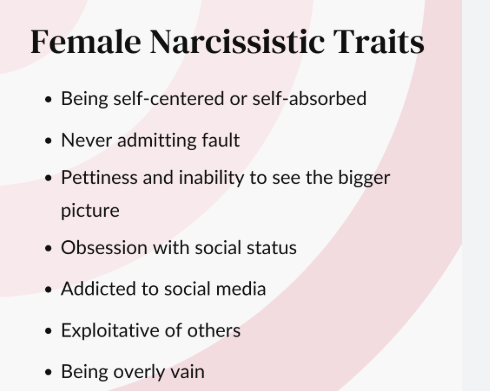Narcissist Traits in Females – Signs, Behaviors & Relationship

Narcissism is often discussed in general terms, but its expression can differ between men and women. Female narcissists may not always display the same bold arrogance seen in men. Instead, they often use relational strategies, emotional manipulation, or image-focused behaviors to maintain control.
These differences make female narcissism harder to identify, yet just as impactful. Understanding these traits provides insight into how narcissistic women interact with others and the challenges they create in relationships, families, and workplaces.
What Defines Female Narcissism?
Narcissism at its core involves self-importance, lack of empathy, and a strong need for admiration. In women, these qualities often emerge in more subtle forms. While some women may appear confident and charming, beneath the surface lies a deep insecurity that fuels constant demands for validation.
This insecurity often hides behind emotional displays, manipulation, and carefully crafted public images. Female narcissists may seem nurturing or supportive in social settings, yet privately, they undermine, criticize, and control those closest to them. The contrast between their public and private selves creates confusion for friends, partners, and colleagues.
Common Traits of Female Narcissists
Constant Need for Attention
A female narcissist seeks validation endlessly. Compliments and admiration serve as emotional fuel. Without attention, she becomes restless and irritable. She may use appearance, charm, or dramatic storytelling to draw focus. Social media often becomes a stage where she can curate the admiration she craves. This endless pursuit of validation leaves those around her feeling drained and unappreciated.
Lack of Genuine Empathy
Empathy is often shallow and self-serving. She may appear to care when it benefits her, but genuine concern for others is missing. Friends or partners who share struggles may find their feelings minimized or redirected back to her experiences. Over time, this pattern creates emotional distance, as others begin to feel invisible. Relationships then become one-sided, with her needs always at the center.
Manipulation and Control
Manipulation is a key trait of narcissism in women. Rather than direct aggression, many rely on emotional tactics. Guilt-tripping, passive-aggressive comments, and silent treatment are common. She may also use triangulation, drawing others into conflict to create division and gain control. At times, she portrays herself as the victim to secure sympathy and compliance. This behavior erodes trust and leaves others constantly second-guessing themselves.
Hypersensitivity to Criticism
Female narcissists are highly sensitive to even mild criticism. Any suggestion of fault is seen as a personal attack. Reactions may include anger, tears, denial, or shifting blame onto others. She may punish criticism with silent treatment or emotional withdrawal. This hypersensitivity makes open communication difficult, as others feel silenced or afraid to speak honestly. The result is an unstable emotional environment where genuine dialogue cannot thrive.
Envy and Rivalry
Competition is another defining feature. Female narcissists often envy others, especially women they see as rivals. Instead of celebrating success, they belittle, gossip, or undermine. They may subtly insult peers or spread doubt about others’ abilities. This jealousy damages friendships and professional relationships alike. At the root lies insecurity and fear of being overshadowed.
Obsession with Appearance and Image
Image often takes center stage. A female narcissist may be preoccupied with fashion, beauty, or status symbols. Her public image matters more than private authenticity. Social media becomes a platform to display perfection, even if reality is far different. She may exaggerate achievements or fabricate stories to maintain admiration. Beneath this focus lies insecurity, yet the outward presentation remains polished and flawless.
Gaslighting and Blame-Shifting
Gaslighting is a common tactic. She may deny past actions, twist conversations, or insist that others are misremembering events. Over time, this makes others question their reality. She rarely accepts responsibility, preferring to shift blame. Mistakes become someone else’s fault. Those close to her often feel trapped in cycles of guilt and confusion, unsure of their own judgment.
READ MORE
Female vs Male Narcissism
While both men and women with narcissistic traits display entitlement and lack of empathy, the expression often differs. Men tend to show more overt arrogance and dominance. Women lean toward covert strategies, using relationships and emotional influence as tools. Female narcissists are often more associated with vulnerable narcissism, marked by insecurity and emotional volatility.
These differences can lead to misdiagnosis, as female narcissism sometimes resembles borderline personality patterns. Yet the motivation is different. Female narcissists act to protect fragile self-worth, often by undermining others.
Impact on Relationships

Romantic Partnerships
Romantic partners often experience an emotional rollercoaster. At first, affection and charm draw them in. Later, criticism, withdrawal, and devaluation replace warmth. Partners may feel confused by cycles of love-bombing followed by rejection. Gaslighting deepens the confusion, leaving partners questioning their worth and sanity. Over time, emotional health declines, and self-esteem suffers.
Family and Friendships
Family members and friends face similar patterns. A female narcissist may use favoritism to control relationships within families. Children may feel pressured to meet her expectations while facing criticism when they fall short. Friends may be valued only for their usefulness, whether for social status or emotional support. Once their usefulness fades, they may be discarded or belittled. These dynamics damage trust and create lasting scars.
Work and Social Life
In professional settings, female narcissists may undermine coworkers to secure advancement. They might present charm to superiors while dismissing or exploiting colleagues. This creates toxic workplaces where trust is scarce. Socially, they may appear popular and well-liked, yet much of this image is built on manipulation and competition. Beneath the surface, many relationships remain shallow and unstable.
Coping and Protection
Recognize the Patterns
Awareness is the first step. Occasional selfishness does not define narcissism. Instead, look for repeated behaviors such as lack of empathy, manipulation, and constant need for admiration. Recognizing patterns helps avoid confusion.
Set Boundaries
Boundaries protect mental and emotional health. Saying no without guilt and limiting emotional investment are key. A narcissist may resist boundaries, but holding firm is necessary for self-preservation.
Limit Confrontation
Direct confrontation often fuels defensiveness. Instead of seeking validation from the narcissist, focus on controlling your own reactions. Avoid power struggles that drain energy.
Seek Support
External support is critical. Talking with trusted friends, therapists, or support groups provides perspective and validation. Isolation deepens confusion, while outside input restores clarity.
Consider Distance
Sometimes, the healthiest option is distance. When emotional abuse, manipulation, or control continues, stepping away may be the only way to protect well-being. Choosing self-preservation is not weakness but strength.
READ MORE
Conclusion
Female narcissists may not always appear obvious, but their impact is profound. Their traits revolve around manipulation, emotional control, envy, and obsession with image. Unlike male narcissists, they often operate through subtle tactics rather than open dominance.
Relationships with them can leave others drained, confused, and doubting themselves. Recognizing these traits is essential for setting boundaries and protecting mental health. While not every challenging woman is a narcissist, awareness of patterns helps individuals navigate relationships more wisely.
